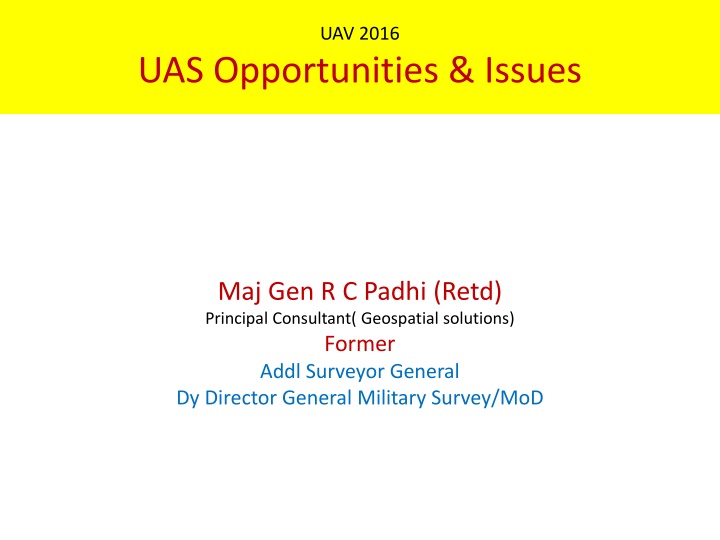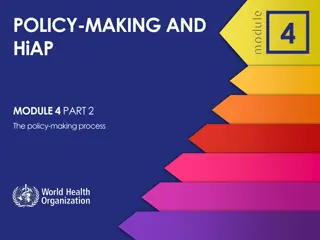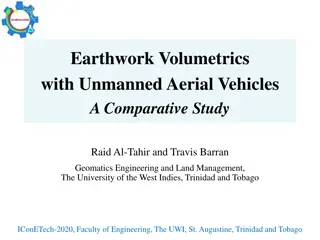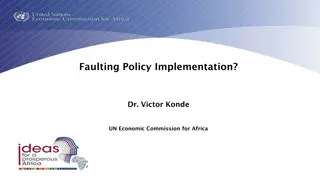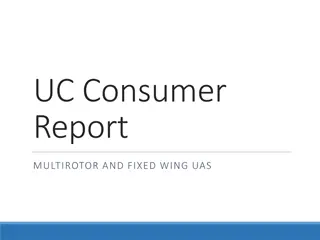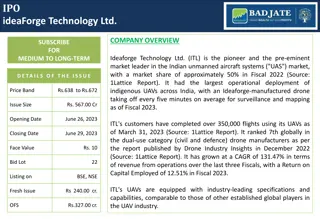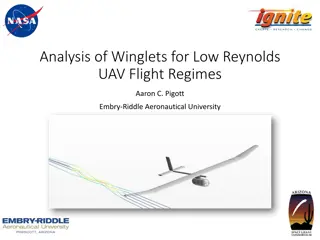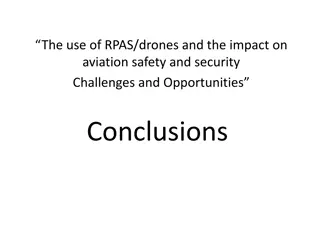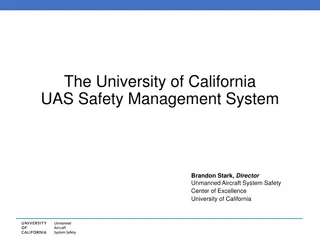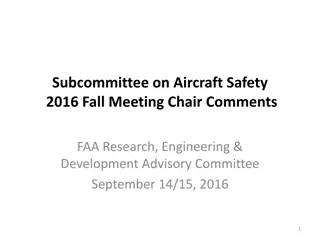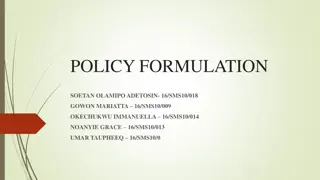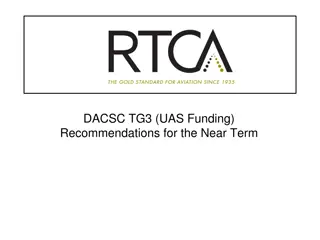Overview of UAVs and UAS: Opportunities, Issues, and Policy Developments
Unmanned Aerial Vehicles (UAVs) and Unmanned Aerial Systems (UAS) offer a wide range of opportunities and applications, from military missions to commercial use. Recent policy developments in the US, including funding for research and guidelines for UAV operation, aim to promote the adoption of drones across various sectors. However, concerns such as privacy, security, and ethical implications of drone strikes remain relevant. The history of drone technology traces back to the 19th century, highlighting both its military and civilian applications. As the industry continues to grow, regulations and policies play a crucial role in harnessing the benefits of UAVs while addressing potential challenges.
Download Presentation

Please find below an Image/Link to download the presentation.
The content on the website is provided AS IS for your information and personal use only. It may not be sold, licensed, or shared on other websites without obtaining consent from the author.If you encounter any issues during the download, it is possible that the publisher has removed the file from their server.
You are allowed to download the files provided on this website for personal or commercial use, subject to the condition that they are used lawfully. All files are the property of their respective owners.
The content on the website is provided AS IS for your information and personal use only. It may not be sold, licensed, or shared on other websites without obtaining consent from the author.
E N D
Presentation Transcript
UAV 2016 UAS Opportunities & Issues Maj Gen R C Padhi (Retd) Principal Consultant( Geospatial solutions) Former Addl Surveyor General Dy Director General Military Survey/MoD
UAS: News Update The White House Office of Science and Technology Policy has announced on 2 August actions to encourage adoption of unmanned aerial vehicles (UAVs) across the US. The measures include $35 million in research funding over five years for the design, control, and application of drones in areas such as inspecting electric transmission lines, monitoring agriculture, and studying severe storms. The White House policy states that US will expand federal agencies use of UAVs and accelerate airspace integration research. US Interior Department will employ UAVs in helping protect endangered species and habitats, suppressing wildfires, and increasing accessibility to remote communities. US Federal Aviation Administration(FAA) has issued nationwide guidelines for the operation of commercial UAV weighing under 25 kg and permits drone flights for commercial, scientific, public, and educational purposes. Industry estimates suggest that over the next 10 years, commercial UAS could generate more than $82 billion for the US economy and support as many as 100 000 new jobs. The market potential world wise for UAS is much bigger. The FAA rules prohibits drone flights within five miles of an airport and requires operators to pass a written test and undergo the same security vetting as pilots of crewed aircraft. US has ordered federal agencies to ensure privacy as they adopt use of UAVs. The guidelines provides examples of technologies and practices that regulates drone operators collecting information.
UAS:Introduction Unmanned aerial vehicles (UAVs), known as drones, are remotely-controlled aircraft which may be armed with missiles , weapons for attack missions as well as deployed for many civilian applications. After World Trade Center attacks of 09/11, 2001 and subsequent "War on Terror," USA has used thousands of drones to neutralise suspected terrorists in Pakistan, Afghanistan, Yemen, Somalia. Drones have decimated terrorist networks with precise strikes & minimal civilian casualties. UAS military and civilian applications increasingly propelling its growth and business. UAS are relatively inexpensive surveillance systems/weapons and their use helps reduces ground combat minimizes casualty. Drone strikes raises issue of likely civilians casualties, violation of international law and sovereignty of other nations but a force multiplier. With right law/ policies India can benefit from UAS for defence , national development and economy.
UAS : History The first recorded use of attack drones occurred on July 15, 1849 when the Austrian Empire launched 200 pilotless balloons armed with bombs against the revolution-minded citizens of Venice. According to 2013 survey, 61% of Americans supported drone strikes in Pakistan, Yemen, and Somalia. The first targeted drone strike by the USA occurred on Feb. 4, 2002 in Afghanistan. CIA Predator drone fired on a group they believed included Osama bin Laden however the target, all killed, were civilians gathering scrap metal. Common drone used for attack purposes has a long range (3,682 miles), high operational altitude ( 50,000 ft) and Long endurance (flight time o 27 hours.) Civilians accounted for 8-17% of all deaths from US drones in Pakistan, Yemen, and Somalia.
UAS : Indian Defence Sector IA/IAF/IN need more than 5,000 UAVs over the next 05-10 years Tenders restricted to Global/domestic companies /consortiums firms. Limited industrial expertise, manufacturing delays and cost overruns, have adverse impact on past efforts to develop/ produce indigenous UAVs. Private sector will be involved big way to meet future requirements of UAVs, as per MoD strategy. Next five years, the IA can equip UAVs down to the battalion level, while the Air Force will have fully operational squadrons of surveillance UAVs and unmanned combat aerial vehicles (UCAV). Portable mini and micro UAVs for short-range surveillance, and nuclear, biological, chemical detection in the battlefield is a necessity. IA, IAF and IN need increasing for tactical UAVs.High-altitude long-endurance HALE) vertical take-off and landing (VTOL) and medium-altitude, long-endurance (MALE) UAVs.
UAS: Make in India DRDO has been engaged for developing varieties of UAVs for the three services. IAF: Rustom UCAVs with ground station . stealth UCAVs named autonomous unmanned research aircraft (AURA) .Ground station for Nirbhay UAVs and of Lakshya-II remotely piloted high speed target drones IN: Rustom UCAVs with ground station . MALE Rustoms , Pawan mini UAVs . air- and ship- launched Nirbhay UAVs, rotary UAVs, Netra micro UAVs ; and Gagan tactical UAVs of Israel origin. IA: Rustom UCAVs and with ground station and Rustom-2 UCAVs ; Nishant UAVs; and hybrid mini-UAVs and one ground station. GSQR for IA requirement is ready. DRDO supplying about Netra micro UAVs to Indian paramilitary forces. DRDO expected to float tenders for development of bomber and fighter UAV. DRDO has ongoing projects for development of independent unmanned surveillance air vehicle and looking at developing solar-powered HALE UAV. Presently IA/IAF/IN are operating Israeli origin Searcher Mark I, Searcher Mark II, Heron and Herop UAVs and the Indian-made Nishant UAV.
UAS : Civil Sector Non-military Drones have become inexpensive and accessible. It is just a matter of time before regulations are lifted and they are more widely used.The following are some Drone Applications and Uses Journalism, Filming and aerial photography Drones in sports photography and cinematography used in the Olympics for filming skiing and snowboarding events. The ability to collect footage for live broadcast is a real possibility . Real Estate :Aerial photography for the Real estate market is becoming popular . Shipping/ Delivery While the GoI is not in favor of Drone delivery, company s like Amazon, UPS and DHL see its potential. Drones can be used to deliver small packages, pizzas, letters, medicines, beverages etc. at short distances Disaster Management In natural or man made disaster, drone provides a quick means to gather information with high definition cameras and radars. Drones give rescuers access to a higher field of view provides close-up view of areas. Search and Rescue/ Healthcare With thermal sensors, drones quickly discover the location of lost persons, and are particularly useful at night and difficult terrain. Drone could be used to drop in supplies to unreachable location..
UAS : Civil Sector Surveying/ Mapping Drones can acquire very high-resolution data to create 3D maps. The technology is already in use OpenStreetMap. Agriculture Agricultural use of drones could comprise 80% of the market. This include the need to closely monitor crops. Near-infrared sensors used for crop health. Wildlife Monitoring/Pooching The presence of drones has proven to serve as a deterrent to poachers. The ability to operate at night, and with thermal camera sensors, drones provide protection to wildlife. Law-Enforcement and police patrol Helps with crowd surveillance and public safety, h monitoring criminal activity, Crime scene and fire investigations,criminal movements, terrorists and and anti social elements with Drones. Construction Sites The monitoring from above of construction project sites , check on projects, compare to plans, as well as better coordination of materials on the job site. Storm Tracking/Forecasting Unmanned systems are the best approach to these dangerous situations, and with specialized sensors. Fun Plenty of hobbyists are picking up drones to play around with, both by flying remotely and by programming drone AI (artificial-intelligence).
UAS : Issues The GoI considering comprehensive Civil Aviation Requirements to regulate small, unmanned aerial vehicles (UAVs, or drones ), following recent incidents of their flying close to the airport, and Indian parliament. Guidelines likely to include registration, tracking, implementation, and penalties for offenders. The DGCA and security agencies are facing technical challenges like tracking in general and particularly to track recreational drones. Tracking costs money and increases the weight of a drone. It needs to be monitored, and tracking devices will have to be put across the country. Administrative issues are getting in the way. Even the U.S. is struggling with similar issues,. This is a transition phase. DGCA have restricted use of civilian drones to government purposes only. With no regulations, issues remain undefined and left unaddressed. The problem with an unregulated market with irresponsible usage has a potential threat to public safety. Issues will remain with any regulation. the best way is to formulate a set of regulations, implement them and then keep making appropriate changes. Registration of equipment, permissions based on the merit of the project, and skill of the operator could be considered while formulating the regulations.
Few Suggestions DGCA policy could examine following from US guidelines: USA FAA has removed the requirement of spotters/Visual Observers(VO) which means that UAVS now don t have to have spotters/VOs .UAVs can fly briefly even outside line of sight. FAA has removed the requirement of licensed PPL pilots only. UAV operator alternately undergoes a remote pilot certified course for training and flying UAV. DGCA is required to establish a separate training course for remote pilot certification as soon as possible. Clearance should not be required from DGCA for any flight less than 400ft and permission from local Superintendent of Police(SP)/ Additional District Magistrate(ADM) should be enough. DGCA restriction is 200 ft and above which DGCA clearance is required. UAV Operations Near an Airport Notification and Permissions??.
UAS:FAA Certification model The following is suitable study material for the Remote Pilot Certificate with a small UAS Rating for Unmanned Aircraft General (UAG). These questions are a representation of questions that can be found on all Unmanned Aircraft General tests. The applicant must realize that these questions are to be used as a study guide, and are not necessarily actual test questions. The full UAG test contains 60 questions. The Application Identification, Information Verification and Authorization Requirements Matrix lists all FAA exams (matrix for UAS is attached until test activation). It is available at http://www.faa.gov/training_testing/testing/media/testing_matrix.pdf. The FAA testing system is supported by a series of supplement publications. These publications include the graphics, legends, and maps that are needed to successfully respond to certain test questions. The FAA-CT-8080-2G, Airman Knowledge Testing Supplement for Sport Pilot, Recreational Pilot, and Private Pilot has the supplemental graphics necessary to assist in answering any question on a UAG exam referring to a figure. It is available at http://www.faa.gov/training_testing/testing/test_questions/media/sport_rec_private_akts. pdf. The Learning Statement Reference Guide for Airman Knowledge Testing contains listings of learning statements with their associated codes. Matching the learning statement codes with the codes listed on your Airman Knowledge Test Report assists in the evaluation of knowledge areas missed on your exam. It is available at http://www.faa.gov/training_testing/testing/media/LearningStatementReferenceGuide.pdf.
